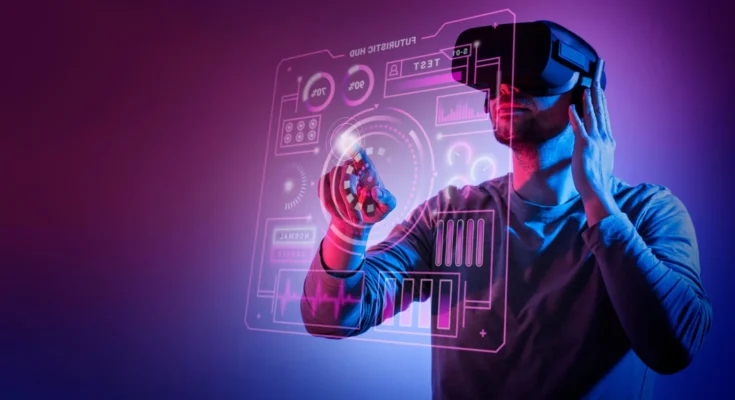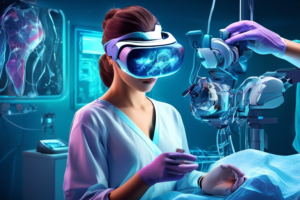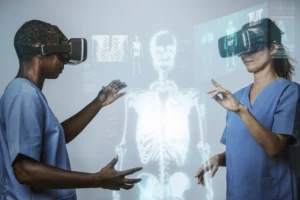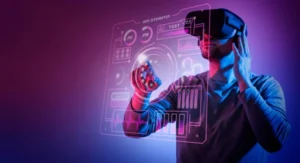Beyond Entertainment: Exploring Virtual Reality’s Applications in Healthcare

Virtual reality (VR) technology has long been associated with the entertainment and gaming industries. However, its potential extends far beyond mere amusement. The use of these new and creative technologies has significantly expanded to other spheres of life, one of which is very significant interior design, which has particularly advanced with the use of virtual reality, as users get the opportunity to view their corner before starting work and choose what they like best, and the excellent custom closets in Tampa, FL can help them achieve just that. In recent years, VR has emerged as a powerful tool with transformative applications in the field of healthcare. This article delves into the diverse ways in which VR is revolutionizing healthcare practices, from diagnosis to treatment and rehabilitation.
Diagnostic Advancements Through Immersive Technology

In the realm of diagnostics, VR offers a novel approach to enhancing medical imaging and visualization. Traditional imaging techniques such as MRI and CT scans provide valuable insights into patients’ conditions, but they often lack interactivity and depth. VR bridges this gap by enabling clinicians to immerse themselves in three-dimensional representations of anatomical structures, facilitating more accurate diagnoses.
Moreover, VR-based simulations allow medical professionals to practice procedures and refine their skills in a risk-free environment. For instance, surgeons can perform virtual surgeries on lifelike models, honing their techniques and reducing the likelihood of errors during actual operations. This not only improves patient outcomes but also instills confidence in healthcare practitioners.
Patient-Centric Care Redefined
Beyond diagnostics, VR holds immense potential for improving patient care and well-being. By transporting individuals to immersive virtual environments, VR can alleviate pain and anxiety associated with medical procedures. Studies have shown that distraction techniques, such as engaging in virtual experiences, can significantly reduce pain perception and enhance patients’ overall satisfaction with their healthcare experiences.
Furthermore, VR therapy is gaining traction as a non-pharmacological approach to managing chronic pain and mental health disorders. Through tailored virtual experiences, patients can learn coping strategies, confront their fears in a controlled setting, and achieve breakthroughs in their treatment journeys. This personalized approach to therapy empowers individuals to take an active role in managing their health conditions. Also, with adequate and comfortable combat clothing, it can contribute to better development of physical activity and readiness and better overall health of the individual.
Enhancing Medical Education and Training
In addition to its clinical applications, VR is reshaping medical education and training paradigms. Traditional methods of teaching anatomy and procedural skills often rely on static textbooks and cadaveric dissections, limiting students’ engagement and understanding. VR simulations, on the other hand, offer an immersive and interactive learning environment where students can explore anatomical structures and practice medical procedures in a realistic manner.
Moreover, VR enables remote collaboration and knowledge sharing among healthcare professionals, transcending geographical barriers. Virtual conferences, medical simulations, and collaborative platforms facilitate interdisciplinary learning and the exchange of best practices. By democratizing access to medical education, VR has the potential to address workforce shortages and improve healthcare delivery worldwide.
Ethical Considerations and Future Implications
While the integration of VR in healthcare presents numerous benefits, it also raises ethical and practical concerns that warrant careful consideration. Privacy and data security issues, as well as the potential for desensitization to real-world experiences, must be addressed to ensure the responsible implementation of VR technology in medical settings. Moreover, disparities in access to VR resources could exacerbate existing healthcare inequalities if left unaddressed.
Looking ahead, the future of VR in healthcare holds immense promise. Continued advancements in hardware, software, and user experience design will unlock new possibilities for personalized medicine, remote patient monitoring, and telemedicine. By harnessing the full potential of VR technology, healthcare providers can enhance patient outcomes, improve efficiency, and ultimately, transform the delivery of healthcare services.
Virtual Reality: Breaking Barriers in Rehabilitation

Virtual reality technology is breaking new ground in the realm of rehabilitation, offering innovative solutions for individuals recovering from injuries or undergoing physical therapy. By creating immersive environments that simulate real-world scenarios, VR enables patients to engage in therapeutic exercises and activities that promote movement, balance, and coordination. From stroke rehabilitation to motor skills training, VR interventions are revolutionizing the way rehabilitation is delivered, empowering patients to achieve optimal recovery outcomes.
Furthermore, VR-based rehabilitation programs can be customized to meet the unique needs and goals of each patient, providing individualized treatment plans that address specific impairments or functional limitations. Whether it’s relearning how to walk after a spinal cord injury or regaining fine motor control following a stroke, VR allows patients to practice activities of daily living in a safe and supportive environment.
Moreover, VR technology holds promise for enhancing patient motivation and engagement during rehabilitation sessions. By gamifying exercises and providing real-time feedback, VR applications can make therapy sessions more enjoyable and rewarding, encouraging patients to actively participate in their recovery process. This increased engagement can lead to better adherence to therapy regimens and ultimately, improved functional outcomes for patients. One of the important applications of such systems is also reflected in finding the best treatment for autism so that children diagnosed with this condition are given the best and adequate therapy.
Empowering Patients Through VR-Assisted Psychotherapy
In the field of mental health, virtual reality-assisted psychotherapy is emerging as a promising treatment modality for various psychiatric disorders, including phobias, PTSD, and anxiety disorders. By exposing patients to virtual environments that evoke their specific fears or triggers, therapists can guide them through exposure therapy in a controlled and safe setting. VR also offers opportunities for cognitive behavioral therapy (CBT) interventions, relaxation techniques, and mindfulness exercises, providing patients with effective tools for managing their symptoms and improving their quality of life. This can help many people in shaping their personalities and overcoming severe fears, especially after some serious accidents and events, in order to overcome some of their fears and anxieties as well as some worries, some people prefer to spend time with animals and visit pet expos, believing that they will find love and support they lack in their four-legged friends.
Moreover, VR psychotherapy can be particularly beneficial for individuals who have difficulty accessing traditional forms of therapy due to logistical or geographical barriers. By delivering therapy sessions remotely through VR platforms, mental health providers can reach a wider audience and ensure continuity of care for patients, regardless of their location. By accessing special therapy groups on online forums and sites, individuals are successfully working to overcome their fears, in addition, an internet service provider that manages IT services in San Antonio provides its users with excellent internet with which they can easily and quickly get this type of help that they need.
Furthermore, VR allows therapists to create customized virtual environments that cater to the individual needs and preferences of each patient. Whether it’s confronting a fear of heights or practicing social interactions in a simulated environment, VR therapy sessions can be tailored to target specific anxiety triggers and challenges faced by patients. By simulating specific environments, a very clear answer is obtained from the patient to the situation in which he is in, and in this way, he can easily work on solving the problem, this is also the work of an excellent science tutor in Boulder who, with his creative approach to students, easily succeeds in helping them overcome and the most difficult subjects and passed all the tests.
Augmented Reality: Enhancing Surgical Precision
While virtual reality has garnered attention for its applications in healthcare, augmented reality (AR) is also making waves in the surgical domain. AR overlays digital information onto the surgeon’s field of view, providing real-time guidance and visualization during procedures. From tumor localization to organ segmentation, AR enhances surgical precision and accuracy, reducing the risk of complications and improving patient outcomes. As AR technology continues to evolve, it holds immense potential for transforming surgical practices and ushering in a new era of minimally invasive surgery. Such progress in medicine was nevertheless expected over the years, bearing in mind the development of new technologies and devices that unstoppably followed the development of telecommunications and the demand for millimeter-wave products.
Furthermore, AR technology enables surgeons to access critical patient data and imaging studies without having to divert their attention away from the surgical field. By seamlessly integrating medical imaging overlays and navigation aids into their visual field, surgeons can make more informed decisions in real-time, enhancing patient safety and surgical efficiency. At European seminars in medicine, such achievements have already been shown, which will be quite applicable and necessary in the future, and if you want to research more about it, rent a car in Beograd and visit one of these events.
Moreover, AR-assisted surgeries can facilitate interdisciplinary collaboration among surgical teams, allowing multiple specialists to view and interact with the same patient data simultaneously. This collaborative approach promotes communication, teamwork, and shared decision-making, leading to better surgical outcomes and patient care. This kind of cooperation can be key and decisive in some operations on patients, and in order for everything to be performed perfectly in the end, adequate and sterilized equipment is also necessary, just as an experienced hairdresser needs sharp Japanese scissors, so in surgery it is extremely important that the instruments are adequate and clean.
VR-Based Pain Management Strategies
Chronic pain affects millions of people worldwide, often leading to diminished quality of life and functional impairment. Virtual reality offers a non-pharmacological approach to pain management, providing individuals with immersive experiences that distract them from their discomfort and promote relaxation. VR-based pain interventions range from immersive nature scenes to interactive games and guided meditation sessions, offering patients a personalized and engaging way to cope with their symptoms. By harnessing the power of VR, healthcare providers can empower patients to take control of their pain and improve their overall well-being. However, you should not rule out the possibility of diagnosing and improving your car at a transmission service in Buffalo and comfortably and safely immerse yourself in a refreshing trip to nature where the sounds of nature will help you overcome the pain.
Furthermore, VR technology can be integrated into multimodal pain management approaches, combining virtual reality with other therapeutic modalities such as physical therapy, mindfulness-based interventions, and pharmacological treatments. By addressing the physical, psychological, and emotional aspects of pain, multimodal approaches can provide comprehensive relief for individuals suffering from chronic pain conditions. Some of the most intense pains are found in people who sit for a long time at the workplace in front of the computer, which is why in that case it is best to combine these VR capabilities with an excellent ergonomic keyboard and equipment that will contribute to proper physiological posture and reduce pain.
Moreover, VR-based pain management strategies have been shown to have long-lasting benefits beyond the duration of the virtual experience. Studies have demonstrated that regular use of VR interventions can lead to reductions in pain intensity, decreased reliance on pain medications, and improvements in overall quality of life for patients with chronic pain. In addition to this, you will achieve excellent results if you stop from time to time and look back at yourself and your desires and do something just out of self-love, which can be a small piece of luxury like renting a limousine from a limo service in Atlanta for your special event.
Remote Patient Monitoring with VR Technology
In an era of increasingly decentralized healthcare delivery, virtual reality technology is enabling remote patient monitoring and telemedicine initiatives. By equipping patients with VR headsets and wearable devices, healthcare providers can remotely monitor vital signs, conduct virtual consultations, and deliver personalized care plans in real-time. VR-enabled telemedicine offers advantages such as enhanced accessibility, convenience, and patient engagement, particularly for individuals with limited mobility or living in rural areas. As telehealth continues to gain traction, VR technology will play a pivotal role in expanding access to healthcare services and improving health outcomes on a global scale. It is very useful for certain chronic patients who struggle with their diseases every day to have access to good care and professional advice even when they are in the comfort of their own homes, and to make them feel as safe as possible they can install useful security access control systems from Philadelphia that will contribute to a greater sense of security in the home.
Furthermore, VR-enabled remote patient monitoring can facilitate early detection of health issues and timely intervention, leading to improved disease management and prevention of complications. By collecting real-time data on patients’ health status and behavior patterns, healthcare providers can identify trends and risk factors, allowing for proactive and personalized interventions. Although this is still in the stages of development and patenting, it is still getting the necessary promotion and popularity because this kind of healthcare application would change the lives of many people, and if your business also needs good promotion, you can turn to an excellent Colorado Springs SEO company that will create a successful plan for your promotions.
Moreover, VR technology enhances the patient-provider relationship by fostering more meaningful and interactive interactions between healthcare professionals and patients. Through virtual consultations and remote monitoring, patients can receive timely support and guidance from their care teams, leading to greater satisfaction and engagement in their healthcare journey. This type of motivation can significantly help them persevere through some of their health struggles, generally maintaining a constant presence and good relationships can result in excellent results both in medicine and in other fields such as excellent online courses.
Ethical Implications of VR in Healthcare
The integration of virtual reality technology in healthcare raises complex ethical considerations that must be carefully addressed. From issues of patient privacy and consent to the potential for bias in algorithmic decision-making, ethical frameworks must be established to ensure responsible and equitable use of VR in medical settings. Moreover, considerations of digital equity, cultural sensitivity, and the impact of VR on patient-provider relationships require ongoing dialogue and collaboration among stakeholders. By prioritizing ethical principles and incorporating diverse perspectives, the healthcare community can harness the benefits of VR while mitigating potential risks and disparities. That is why it is very important to work on solving these ethical issues so that the development of this kind of medicine can be directed to the next steps and if you want to participate in that you can rent a car in Beograd and visit some medical conferences in Europe.
Furthermore, ethical considerations extend to the development and deployment of VR technology, including issues related to data security, informed consent, and the potential for unintended consequences. Developers and manufacturers must adhere to ethical guidelines and industry standards to ensure the safety, privacy, and dignity of individuals who interact with VR systems in healthcare settings. Ethical issues such as these and many other issues have hindered the development of medicine for many years, but are nevertheless very important in order to maintain the morality and humanity of medical procedures, young members of Readathon school fundraiser organizations working to develop their good reading skills hobbies also encounter various philosophical and ethical works of literature that in many ways direct and form opinions.
Moreover, healthcare professionals have a responsibility to advocate for equitable access to VR technology and ensure that vulnerable populations are not marginalized or excluded from its benefits. By promoting digital literacy and addressing disparities in access to technology, healthcare providers can help bridge the digital divide and promote health equity for all. Numerous companies participate in these campaigns and offer various promotional products in order to spread awareness about the importance of technological and basic literacy among the population.
Future Frontiers: Exploring VR in Medical Research

As virtual reality technology continues to evolve, its potential applications in medical research are expanding at a rapid pace. From drug discovery and clinical trials to neuroscience and rehabilitation studies, VR offers researchers unprecedented opportunities to explore complex phenomena in immersive and controlled environments. By leveraging VR simulations and data visualization techniques, scientists can gain new insights into human physiology, disease mechanisms, and treatment responses. As interdisciplinary collaborations flourish, VR-driven research endeavors hold promise for driving innovation, advancing medical knowledge, and ultimately improving patient care. All this is useful and successful progress in the world of medicine that requires a standing ovation and celebration of these hard-working people who work to maintain world health, if you are definitely planning a celebration and want the atmosphere to remain cheerful and positive, don’t forget to hire an emcee.
Furthermore, VR technology enables researchers to conduct experiments and studies that would be impractical or ethically challenging in real-world settings. By creating virtual environments that replicate physiological processes or simulate disease states, researchers can manipulate variables and observe outcomes with precision and control. In addition, the development of virtual reality is so advanced that entire virtual family gatherings can be held with virtual wine glasses and a feast that many family members who are far away can attend.
Conclusion
In conclusion, the integration of virtual reality technology in healthcare represents a transformative shift in the way we approach diagnosis, treatment, and patient care. From rehabilitation and psychotherapy to surgical navigation and pain management, VR offers a multifaceted toolkit for enhancing healthcare delivery and improving patient outcomes. By embracing innovation, addressing ethical considerations, and fostering collaborative research efforts, the healthcare community can harness the full potential of VR to shape the future of medicine and improve the lives of individuals around the world.




